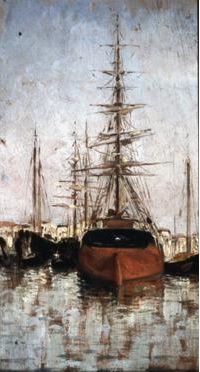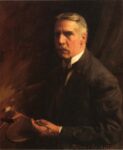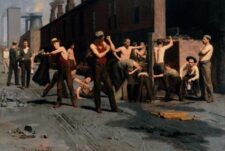
Thomas-Pollack Anshutz
American, 1851-1912
Untitled (Square Rigger at Sea), 1900 ca.
oil on panel
8 1/8 x 4 1/8 in.
SBMA, Gift of Margaret P. Mallory
1991.154.1

Thomas-Pollack Anshutz - Self-Portrait, 1909 ca.
RESEARCH PAPER
Thomas-Pollack Anshutz’s painting “Square Rigger at Sea” is one of the smallest works in the SBMA collection. The painting depicts a square-rigger which is a ship with square rigged sails moored in a line with 3 other ships and the harbor town in the background. Particularly striking is the way the ships reflect on the surface of the water. The sky in the background is fairly cloudy.
Anshutz’s composition is primarily a triangle which is formed by the tops of the ship’s masts and the line of ships. He draws attention to the featured ship by painting its hull orangey red. He places this near the complementary color blue of the water. The red of the hull is a warm color. The rest of the painting is in cool colors. The featured ship is slightly to the right of the center of the painting. Anshutz creates a sense of balance by placing two ships to its left and one ship to its right. He uses both horizontal and vertical lines in the painting. The line of ships is horizontal as well as the spars which carry the sails. Vertical lines are the masts of the four ships.
Anshutz was born in 1851 in Newport, Kentucky. He was primarily educated at the National Academy of Design. In 1875 he moved to Philadelphia where he studied under Thomas Eakins who is considered to be one of the greatest American Artists. Eakins became involved in photography. He incorporated it into both his classes and as tool for his artwork. Anshutz was also known for photographing the world and using the images as studies for his paintings. Anshutz eventually succeeded Eakins as Director of the Pennsylvania Academy of Fine Arts. Anshutz also studied at the Academie Julian in Paris in 1892 and 1893. Due to his duties as a teacher, Anshutz only created about 130 paintings. Anshutz served as a link between the realism of his mentor, Eakins, and a group of his students who became known as the Ashcan School. The Ashcan school was not an organized movement, but a group of friends and former Anshutz students who produced works depicting scenes of daily life in mostly the poorer neighborhoods of New York City.
Anshutz was known as one of the most gifted American art instructors. His first masterpiece and bestknown painting was done while he was still a student. The “Ironworkers’ Noontime” depicts a group of workers on their break in the yard of a foundry. It was brutally candid in the way it depicted the bleakness of factory work. He is largely known for his portraits including a series of the daughter of a trustee of the college where he taught.
The Anshutz family vacationed at Holly Beach, New Jersey which served as a creative place for the painter. Perhaps that is where the painting “Square Rigger at Sea” was painted. The calmness of the sky and water and muted colors feel very relaxing. In the painting one can see the realism influences of Eakins in the way the ships and sails are rendered. There is an attention to details in the rigging and masts. The reflections in the water show a much looser style. Perhaps this could be traced to the influence of the Impressionists who were dominating the Paris art scene while he studied there.
- Prepared for the Santa Barbara Museum of Art Docent Council by Michael Sandler, February 2023
BIBLIOGRAPHY
Anonymous. “Thomas Anshutz”. Smithsonian American Art Museum.
https://americanart.si.edu/artist/thomas-anshutz-109
Anonymous. “Thomas Pollock Anshutz”. Wikipedia
https://en.wikipedia.org/wiki/Thomas_Pollock_Anshutz
Anonymous. “Biography of Thomas Anshutz”. American Art Gallery
http://americanartgallery.org/artist/readmore/id/107

Anshutz - The Ironworkers' Noontime, 1880
SBMA CURATORIAL LABELS
Anshutz succeeded his teacher, Thomas Eakins, as Chief Demonstrator of Anatomy at the Pennsylvania Academy of the Fine Arts, following Eakins’ dismissal in 1886. Eakins was punished for teaching life-drawing classes from the nude male model that included women students, which, at the time, was considered scandalous. Celebrated for his award-winning portraiture, Anshutz was also a devoted landscape painter, conversant with Impressionist techniques. Meticulously observed studies such as this may have been informed by photographs, which Anshutz was known to have used as aides-mémoire.
- Ridley-Tree Reinstallation, 2022
